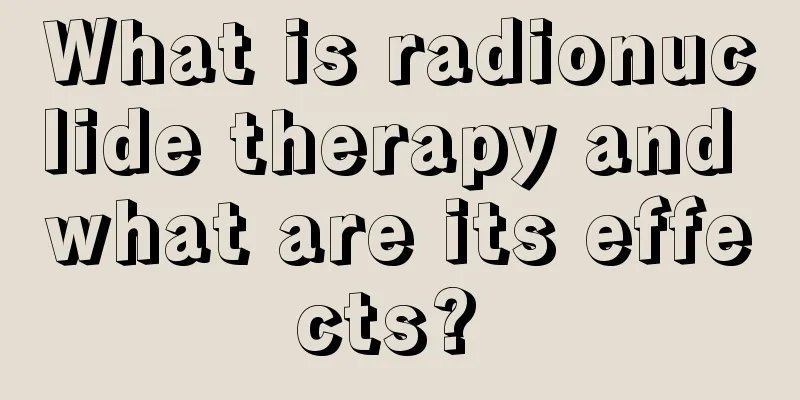What is radionuclide therapy and what are its effects?

|
Nuclear therapy is a method of treating tumors. It refers to the use of radioactive nuclides that emit alpha and beta rays that can powerfully eliminate tumors. Thereby achieving a method of treating tumors. Radionuclide therapy is mainly aimed at tumors and abnormal proliferative tissues in tumors. It also has some contraindications: it is prohibited for pregnant women, people with renal insufficiency and anemia with poor bone marrow hematopoietic ability. If used, it may cause more serious phenomena and accelerate the spread of tumors. Different symptoms have different treatments. Here we will introduce the radionuclide treatment methods. Treatment methods mainly include the following categories: 1. Internal irradiation therapy: Intake or injection of therapeutic radionuclides or radionuclide-labeled molecules. These molecules will be highly aggregated in the diseased target cells and tissues. The alpha rays or beta rays released by the radionuclides can be used to accurately kill the diseased cells and tissues at close range to achieve the therapeutic purpose. 2. Particle or glass microsphere therapy: Iodine-125 is sealed in a titanium tube or yttrium-90 is sealed in a glass microsphere, and transported to the local lesion through interventional methods. The released beta rays are used to accurately kill diseased cells and tissues at close range to achieve the treatment goal. 3. Extracorporeal patch therapy: Generally, radioactive nuclides that emit beta rays, such as phosphorus-32, strontium-90 or yttrium-90, are used. They are evenly adsorbed on filter paper or silver foil. A special applicator is made according to the size and shape of the lesion, which is closely attached to the surface of the lesion. External irradiation is performed on the surface of the body to achieve the therapeutic effect through the action of ionizing radiation. It is mainly suitable for the treatment of skin hemangioma, keloid, intractable eczema and localized neurodermatitis. 4. Boron neutron capture therapy: Injection of boron-10 compounds that target cancer cells and are easily absorbed by cancer cells. When the boron compounds accumulate in cancer cells, they are irradiated with low-energy thermal neutron beams. After absorbing neutrons, the element boron-10 will undergo a nuclear reaction and split into heavily charged particles with strong cell-killing power, namely alpha particles and lithium-7 particles. The flight distance is only the size of a cell and will only destroy a single cell. Normal cells that have not absorbed boron-10 will not be affected by thermal neutrons. Therefore, BNCT is a very promising precision treatment method for malignant tumors. Indications The main indications for radionuclide therapy are malignant tumors and other abnormal proliferative lesions, such as hyperthyroidism, hemangiomas, scars, nodules, etc. Each diagnostic and treatment program has different indications. For example, the indications for iodine-131 treatment include hyperthyroidism and differentiated thyroid cancer, and the indications for lutetium-177 octreotide are neuroendocrine tumors with high expression of somatostatin receptors. Please refer to different programs for specific details. Contraindications Radionuclide therapy often uses strong radioactivity and is not suitable for pregnant women. Breastfeeding women need to consult a doctor about the impact on breastfeeding. Some items may not be suitable for patients with renal insufficiency and insufficient bone marrow hematopoietic capacity. External dressings are not suitable for patients with broken skin. Precautions In addition to informing your doctor of pregnancy and breastfeeding, each radionuclide diagnosis and treatment program may have different precautions, so you need to read the specific notification sheet of the program carefully. Clinical significance By utilizing therapeutic radioactive nuclides and their labeled molecules, through targeted aggregation, intervention or local application, radionuclide therapy can often achieve precise and effective treatment, and has significant therapeutic effects on malignant tumors, hyperthyroidism and refractory skin diseases. The clinical significance of each radionuclide therapy is different. |
<<: What are the treatments for peritonitis
>>: How to treat apical periodontitis?
Recommend
How to do cupping correctly?
Cupping is a common treatment method, so some peo...
How to relieve allergic rhinitis?
The change of seasons is the most difficult time ...
What are the sequelae of finger tendon rupture?
If the ruptured finger tendon is not effectively ...
How to clean a burnt pot?
The pot is an item we use frequently in our daily...
What should I pay attention to in my diet after unilateral resection of thyroid cancer
After unilateral thyroidectomy, there are no spec...
What's wrong with chest pain and numbness in mouth
Only when the human body is healthy can it work b...
There is a section of the back spine that hurts when pressed
Everyone has seen films of the spine on TV. We al...
How to keep your skin moist, white and calm
The quality of skin affects people's physical...
Can peanuts and taro be eaten together?
Peanuts are a very common snack in our lives. Thi...
What symptoms should we pay attention to for prostate cancer and how to prevent prostate cancer
Patients with prostate cancer must pay attention ...
What's wrong with the brown vertical lines on the nails
Many people's nails are relatively smooth and...
Thyroid nodules larger than 1 cm
If people find problems during the physical exami...
If your raincoat is moldy, you can wash off the mold by doing this
Raincoats are items that are often needed in dail...
How to treat hemorrhoids and rectal prolapse_What to do if hemorrhoids cause rectal prolapse
Hemorrhoids are a common anorectal disease for ma...
How to get rid of chin fat
As people age, if they do not pay attention to pr...









